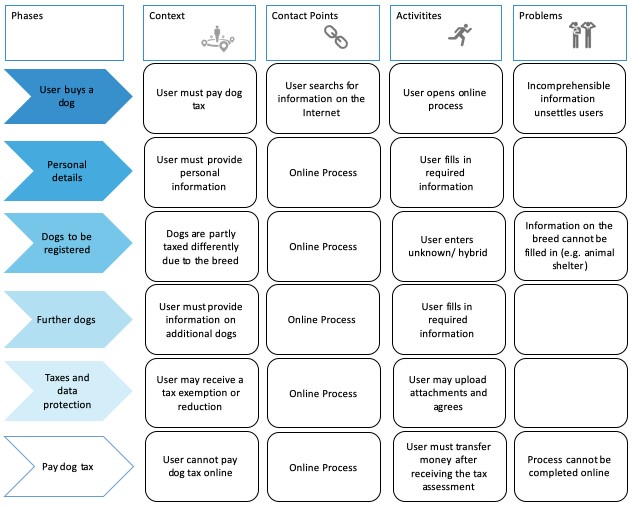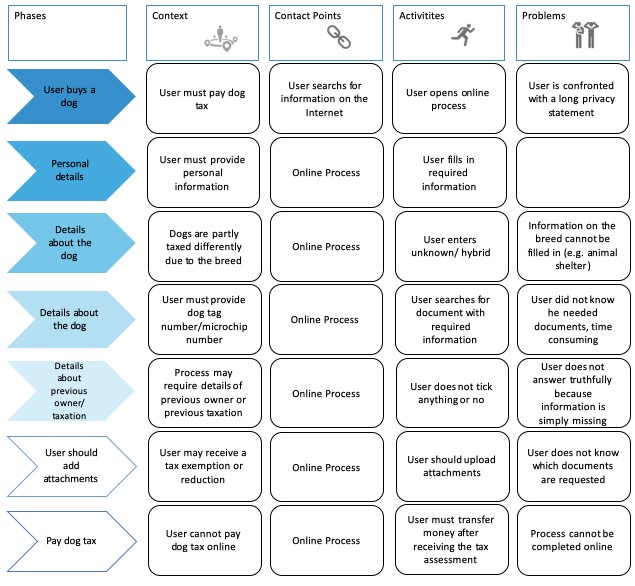
The development of a digital service design in public ad-ministration using the example of the dog tax registration process
Laura Csulits
Abstract
The Online Access Act (Onlinezugangsgesetz - OZG) of the German government, which was passed in 2017, directs public administrations to offer their services to citizens digitally. To ensure that citizens use the online services, they must be designed to be user-friendly, i.e. according to the needs of the users. The dog tax registration is one of the 575 public services covered by the OZG. The process of registering dogs was already offered digitally in two versions at the start of the study. One version as a beta test version on the homepage “Serviceportal Baden-Württemberg” (service-bw.de). And, one version as a digital application procedure, which is provided via a form server (Formularserver). With the help of process-owner and expert interviews as well as through user tests, weaknesses in the digital services and suggestions for improvement were identified. The user tests clearly showed that the digital version on service-bw.de was overall rated better by the users. Changes should be made regarding the information page, the specification of the dog breed and the payment function to improve the digital process in terms of its user-friendliness and effectiveness.
Context
For the successful implementation of the digitization of administrative processes, it is important to take the needs of citizens into account. However, the public administration's and users' understanding of the services are sometimes far apart. Alford (2009) describes how users are often seen as passive actors who are only affected by the outcomes of the service (e.g. tax assessment). So far, users have not been actively involved in shaping the services.
Method
To identify which measures need to be taken to improve the digital process of a dog tax registration in terms of usability and effectiveness, process owner and expert interviews as well as user tests were conducted. The study was carried out for the city of Freiburg im Breisgau.
At the beginning of the study, the dog tax registration process was offered as a beta test version via the service-bw homepage of the state of Baden-Württemberg and as a digital application procedure provided via the form server.
Selection of process owners and experts
Process owners are so-called experts who are familiar with internal administrative procedures and the users of the service (Theil, 2018). With the help of the service-bw process blog, on which news about the progress of digital services are published, various process owners were identified with whom interviews were subsequently conducted.
After the interviews had been conducted and evaluated, it became clear that the process owners had only limited knowledge about the development process of the digital service "Dog registration". In addition, not all cities listed on the service-bw process blog offered the service-bw beta test version. Because of this, another interview was conducted with the official IT service provider of the state of Baden-Württemberg.
Overall, a total of five process owner interviews and one expert interview were conducted. Cities that offer either the service-bw beta test version or the application procedure that is provided via the form server were involved. Cities that for certain reasons did not or not yet offer the service-bw beta test version online, but were advertised as pilot cities on the service-bw process blog, were also interviewed, as they should be familiar with the development of the prototype.
Implementation of the user tests
In general, user tests examine the usability of the services. In this context, user tests help to understand the citizens' view of the process and to involve them in the development process of a digital service.
The subjects for the tests were recruited through the contact person in the Freiburg city administration. Only people who have a dog themselves and will therefore use the process themselves were invited. A total of five user tests were conducted, whereby the users had to play through and comment on the two existing online applications. This procedure is called A/B-Test. A/B-Tests can be used to examine different approaches to determine which one meets the needs of the users. At the beginning, a pre-task interview was held to ask questions about the experiences users have already made with digital services. Then the actual test began, in which two existing online applications were presented to the respondents, which they had to go through independently. The Think Aloud method was used to make sure that the respondents express their thoughts while they were completing an assigned task. In the following post-task interview, questions were asked about the subjective perception and improvements of the online applications (Marsh, 2018). The interviews and user tests were transcribed and analyzed.
Results
From the interviews it became clear that the development of the digital service by the Ministry of the Interior in Baden-Württemberg and the municipal IT service provider can be described as progressive, since on the one hand all users of the process, i.e. citizens (colleagues and family) and administration, are included. On the other hand, ideas are developed until a satisfactory result is achieved.
The service-bw beta test version was rated better overall by the users compared to the application procedure of the form server. In general, the user tests showed that it is primarily important for citizens to find the process easily on the homepage of the respective city. The information about the breed of the dog was rated as inconvenient, since only a selection of the fighting dog breeds was possible. Everything else had to be entered manually. In the mixed breed section, many users struggled when the dog was adopted from the shelter. The trace-ability of the breed of the mother or father is not necessarily given here. This problem occurred in both application procedures.
Theoretical & practical implications
Five points can be derived from the interviews and the user tests to make the digital process of dog tax as user-friendly and effective as possible:
Overall, all users preferred the service-bw beta test version to the form server version, as fewer problems simply occurred when playing through. This can be seen in Figure 1 and Figure 2 (last column Problems).
While the service-bw beta test version only had problems at the beginning and with the specification of the dog breed, additional problems emerged with the form server version. For example, it was possible to upload attachments. Due to missing information the users did not know which attachments might be involved.
The information page of the process, on which for example the prices of the dog tax are listed, should be marked as this. An information, which data and/or which documents are needed, would also be an improvement.
A further finding included the indication of the dog breed. The selection of the dog breeds is currently limited to fighting dog breeds. Other breeds must be entered manually. For this purpose, the approximately 350 dog breeds defined by the Verband für das Deutsche Hundewesen could be included. When selecting mixed-breed dogs and therefore the additional information about the breed of the mother or father animal appears, the possibility unknown should be offered, because there might be an uncertainty when adopting dogs from the animal shelter. Additionally, a comment field could be added to ask why the breed is unknown.
To complete the process, the users would have preferred an online payment function. Since there is currently no online payment option that allows recurring payments, a one-time SEPA direct debit mandate could be used for the time being.
The user tests also asked whether the E-ID of the identity card is used. This was because during the interviews with the process-owner, concerns were expressed that dogs could be registered incorrectly for another person. An obligatory proof of identity via the E-ID of the identity card cannot be recommended, since none of the users has activated this function.
The following graphics contain the user journey derived from the user interviews. The two figures illustrate which phases or steps the users (column "Phases") go through during the application procedure, as well as the problems that arise (column "Problems"). The context of the phase is also considered (column "Context") and which activities the users are conducting (column "Activities"). The column "Contact points" shows how the users come into contact with the administration.

As figure 1 shows, problems occurred at the beginning of the service-bw process regarding the information entry, since the users did not know what the next steps should be due to an incomprehensible information page. There were no problems with the provision of personal data. A further problem arose with the breed. Some users could not provide clear information. However, this is decisive for taxation. While the next steps, with regard to the declaration of further dogs and the upload of required documents, did not cause any problems, the last step of the payment was not satisfactory for the users, because the full process cannot be completed online. The option of an online payment is missing.

Figure 2 shows that right at the beginning problems with the privacy statement occurred, which covered the entire display and were therefore not readable by any of the users. Problems also occurred during this process, as it was not possible to give exact details of the breed of shelter dogs. In addition, the users were asked to upload documents without prior knowledge, which meant a lot of extra work until the relevant documents were put together. The information about the previous owner cannot be filled out truthfully, because in the case of shelter dogs it is often unknown or information is unavailable. Subsequently, the users should upload attachments, but there is no indication of what kind of attachments they might ask for. The last step of this process was not satisfactory for the users, because payment options are missing here as well.
Key Points
The development of digital services can be considered as progressive, as different groups of people are involved in the development. Nevertheless, more attention must be paid to the user tests so that not only citizens in the sense of colleagues and family are surveyed, but also citizens who will use the service and thus have case-sensitive insider knowledge. Using the example of the dog tax registration process, only dog owners need to be interviewed and thus one would have a direct insight into the user-friendliness and effectiveness of the process.
The method of the A/B-Testing has the possibility to compare two versions directly and to evaluate together with the users which steps have to be changed or adapted. This has the advantage that users are involved in the further development through direct feedback and thereby it is guaranteed that corresponding changes are user-friendly.
With the help of the user-journey a new process can be developed and potential problems were avoided or solved. The user-journey can be used as a guideline for the development of new processes because citizens are actively involved in the development and this way a broad acceptance and satisfaction is guaranteed. Functioning phases are maintained, problems are revised.

Laura Csulits:
From 2016 to 2020 Laura Csulits studied Politics and Public Administration at the University of Constance, focusing on management and public administration. Since her bachelor's degree, Laura Csulits has been working as the personal assistant of a member of the Baden-Württemberg state parliament.
